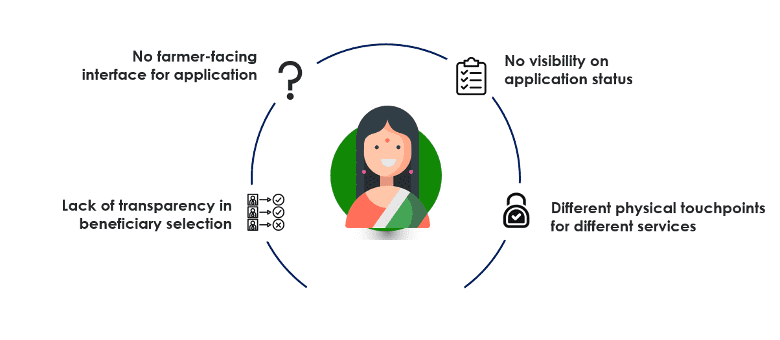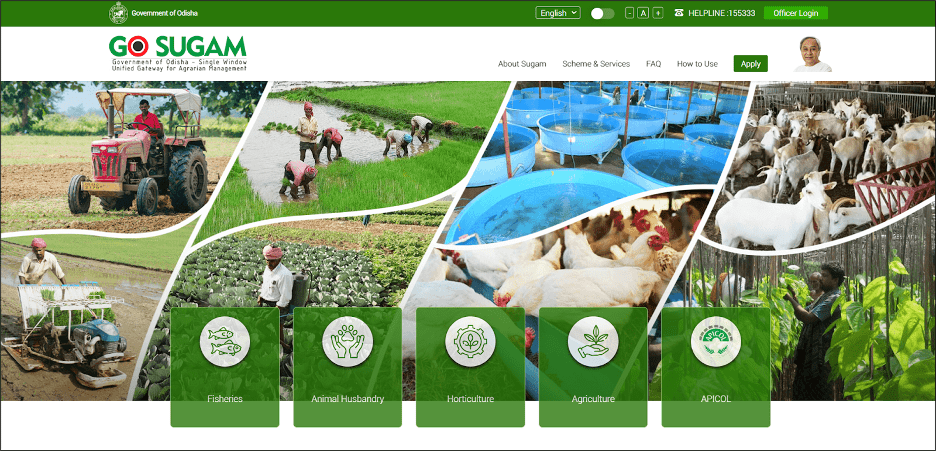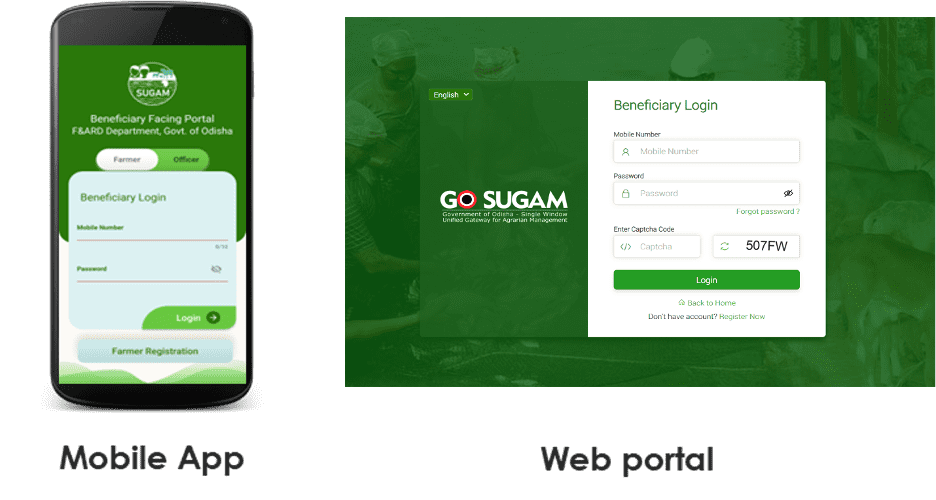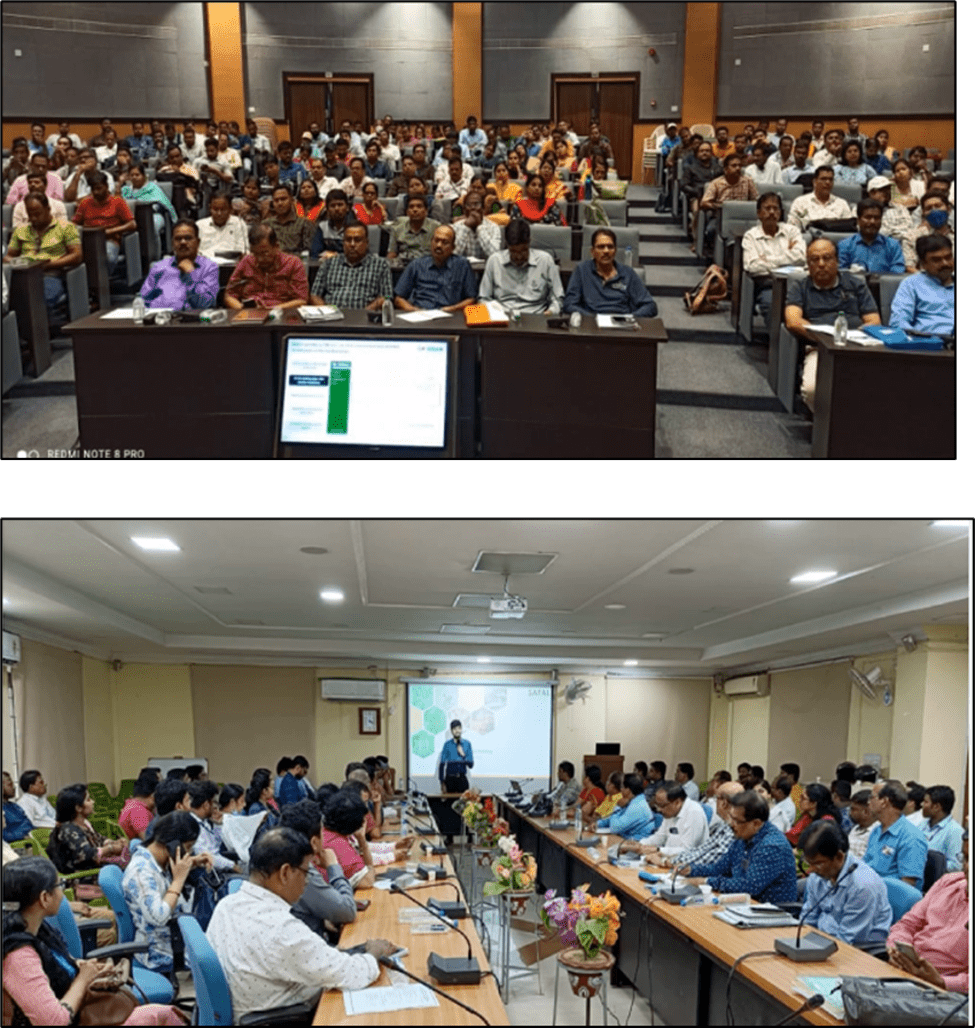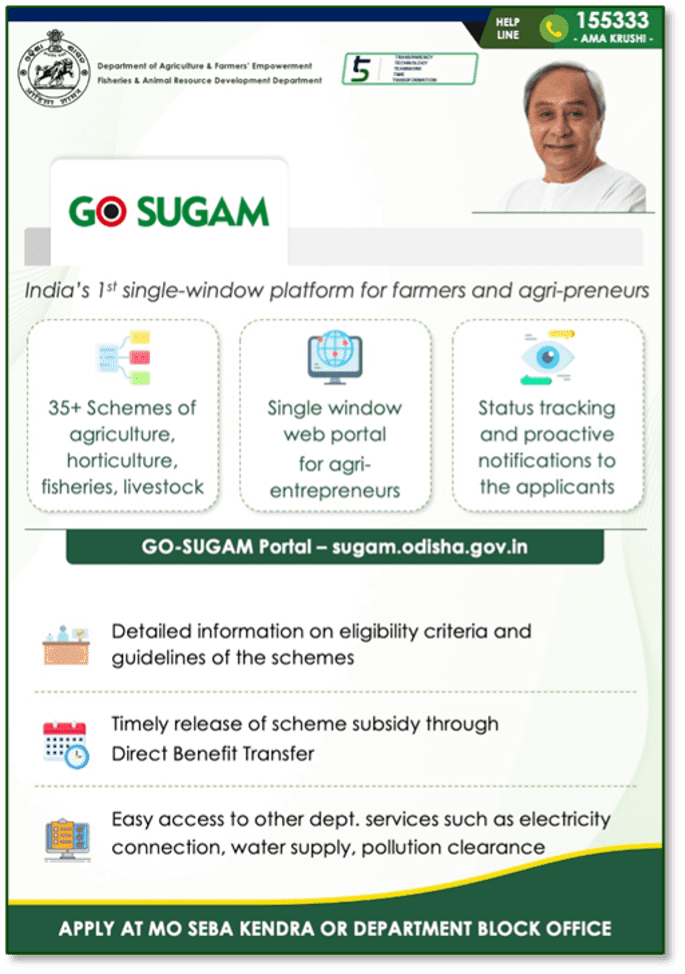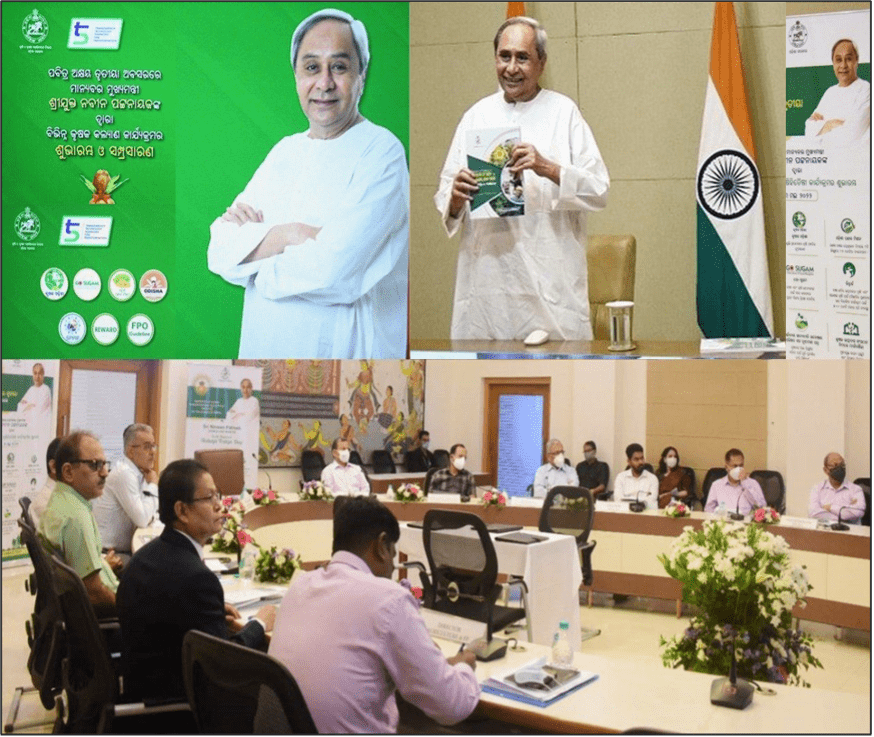Government of Odisha’s single window portal for digital delivery of agricultural schemes to farmers
"The path to the country's prosperity passes through the fields and barns of the villages." This quote by Chaudhary Charan Singh, in whose memory India celebrates the National Farmers Day (Kisan Diwas), aptly summarizes the importance of farmers in a society. India needs a very strong and robust farming sector to feed its 130 Crore plus citizens as well as to become a powerhouse in agricultural exports. With the aim to support farmers, Central and State governments introduce multiple schemes and services to incentivize farmers to adopt new agricultural practices, such as crop diversification for better climate resilience and a better yield & income and promote livestock and fishery activities to supplement their farming income.
Odisha is an agrarian state with 62% of the population working directly or indirectly in the agrarian economy. The Department of Agriculture and Farmers’ Empowerment (DA&FE) and Fisheries and Animal Resource Development Department (F&ARD) are the two primary departments catering to farmers’ needs in the state of Odisha. The gamut of Agriculture, Livestock and Fishery related schemes and services in Odisha encompasses more than 80+ schemes, budgetary provision of more than Rs. 10,000 Cr and impacts the lives of more than 40 Lakh farmers every year. Given the scale at which beneficiaries as well as subsidies are involved, it is important first to understand the different types of schemes in the agriculture and allied sector.
Types of schemes that exist in the Agriculture & Allied sector
Schemes in the Agriculture and Allied sector can be understood based on the following questions:
1. Who is providing the budget?
Budget for a scheme can be provided exclusively either by the State Government (State plan schemes) or the Central Government (Central Sector Schemes). Budget for some schemes is provided jointly by the Central and State governments and these schemes are known as Centrally Sponsored Schemes.
2. When is the subsidy being given?
Subsidies are generally either Front-end or back-end subsidies. The front-end subsidy is when the farmer is typically paying an already subsidized amount. To take an example from our daily lives, buying a subsidized cooking gas cylinder at a lower rate than market prices is an example of front-end subsidy. On the other hand, back-end subsidies are typically used where some asset is getting created and subsidy is given post verification of the created asset. For example, you want to start a small poultry farm. In back-end subsidy schemes, you will first establish the farm at full cost and then claim the subsidy under a particular scheme.
3. What support is being provided?
In some schemes, economic support in terms of monetary incentive is provided after completing a project. Monetary subsidies are generally given where some type of asset is being created. On the other hand, some schemes provide support in kind. For example, a certain number of birds are given directly to beneficiaries to promote backyard poultry. In these types of schemes, the primary aim is to aid the subsistence of farmers.
4. What is the demand for the scheme?
The universe of schemes can be broadly divided into ‘Push’ based and ‘Pull’ based schemes. Typically, ‘Push’ based schemes are schemes which are strategically important for the department to achieve the State’s long term goal in Agricultural production but there is no apparent demand from farmers on ground. In such cases, the scheme is ‘Pushed’ to targeted farmers & beneficiaries are identified in strategic areas by giving specific targets to the departmental hierarchy. On the other hand, there are some schemes which are both strategically important and have gathered enough momentum on ground so that beneficiaries are pro-actively applying to the schemes. These schemes are called ‘Pull’ based schemes and the long term objective of any department is to move most of the schemes from ‘Push’ based to ‘Pull’ based schemes.
Given the multiple types of schemes and services available, a natural question that arises is how does a farmer in a village in Odisha avail these schemes and services?
The need for a ‘Single Window’ portal for scheme and service delivery
In a quaint village of Odisha in 2010, Ramesh was faced with a daunting challenge when he secured admission to his dream undergraduate college. With just two days to gather 7-8 essential documents, he embarked on a frantic journey through local government offices, navigating bureaucratic hurdles and long queues. Fast forward to 2024 and the digital landscape has transformed Ramesh's experience. Now, armed with digitally issued and securely stored documents in DigiLocker, the once-stressful process has become a seamless and stress-free affair. In the heart of rural Odisha, Ramesh's tale mirrors the broader impact of technology, turning a once-arduous quest for paperwork into a story of convenience and relief for India's citizens.
Similarly, Rashmi ji, is an enterprising farmer but she does not have the means to access, understand and apply for government schemes and services which is keeping away from her true potential.
Government schemes and subsidies are key for farmers to set-up or expand their practices in the agriculture and allied sector. Delivery of these schemes & services is an aspect of governance that touches almost every farmer in the state at multiple points in their lifetime. However, farmers are unable to optimally accrue the benefits from these schemes due to opaque processes and insufficient support. The department officers also face many challenges in efficiently delivering the schemes and services on the ground as they are not equipped with the right systems and enablers.
Challenges faced by farmers & agri-entrepreneurs in availing schemes and services
The process of scheme delivery was critically examined from the lens of Rashmi ji and multiple challenges were observed. Let us understand these challenges in detail.
1. Awareness: Even though the state had multiple schemes for the benefit of farmers, Rashmi ji was not aware about those schemes as details of the schemes were not available digitally in a single place. The scheme guidelines were kept either in offline mode available only to the officials or were uploaded on department websites where they were hard to find.
2. Accessibility: If Rashmi ji did get to know about a scheme which she wanted to avail, she had no way of knowing where to apply for that scheme and its process. There was no farmer facing interface for scheme or service applications. She had to visit government offices to submit her documents and go through a complex application process to apply for any scheme and service. In addition to this, for some schemes, individual scheme portals were developed creating confusion in her mind.
3. Visibility: Since beneficiaries were identified by the department officials, there was lack of transparency in the selection of the ‘right’ beneficiaries, i.e. farmers who needed the scheme the most. In the case of Rashmi ji, even if she was able to apply for the scheme, there was no visibility around the status of her application.
4. Multiple touchpoints for Agri-entrepreneurs: Agri-entrepreneurs needed to avail permissions and licenses from other government departments (for e.g. clearances from pollution board) to set-up commercial and semi-commercial units. Multiple government touch-points (both online and offline) made it difficult for the Agri-entrepreneurs to navigate through the landscape.
The process of availing schemes was riddled with multiple challenges for a farmer
Challenges faced by Department staff in scheme and service delivery
Just like the challenges faced by beneficiaries like Rashmi ji, Naresh ji, a department official also faced multiple challenges in delivery of the scheme and services.
1. Demand visibility: As all the schemes were running in ‘Push’ based manner, the aim of the official was to identify the target number of beneficiaries the scheme could be distributed to. This meant that there was no record of willing beneficiaries who could not get the scheme due to the constraints of the targets. Thus, the true need of farmers was not reflected in the annual planning of the departments.
2. Application processing & documentation: Officers had no visibility on pendency of applications within their jurisdiction. They were not aware as to how many applications are pending with which officer and for how long, making it difficult for them to debottleneck application processing for farmers. Crucial time and effort was spent by the officers in maintaining physical records and paper trails of all scheme applications.
3. Tracking & monitoring: Tracking and monitoring used to happen through excel sheets. This was also being done post-facto and there was significant time-lag leading to no room for course correction especially for time-sensitive schemes.
Department officials also faced multiple bottlenecks in scheme and service delivery
Thus, GO-SUGAM (Government of Odisha - Single Window Unified Gateway for Agrarian Management) was developed as part of the KONNECT program to solve these challenges especially for ‘Pull’ based schemes. Samagra’s KONNECT team with support from the Bill & Melinda Gates Foundation is working with the Department of Agriculture & Farmers’ Empowerment (DA&FE) and Fisheries and Animal Resource Development (F&ARD) Department, Government of Odisha to improve the income of farmers in the state. It intends to do this by making the markets work for the farmers and by enabling the agri-value chain to operate at a higher equilibrium. To this end, the program aims to reduce information asymmetry and increase the choices available to farmers.
The GO-SUGAM Web Portal
The journey of developing a technological product within the government which covers multiple departments and directorates can be very challenging. In the case of GO-SUGAM the process primarily involved development of the tech product and adoption of the tech product across the state among both the farmers and officials. Let us try to understand both these things.
Development of GO-SUGAM
GO-SUGAM is designed to have 3 key features:
1. Web Portal and Mobile Application - The solution has a web portal and mobile application to ensure ease of access to beneficiaries. The mobile application is available offline as well, thus helping the officials to do verification of beneficiaries in remote villages with limited telecom network bandwidth. The web portal and mobile application is integrated with external departments to ease the application process for Agri-entrepreneurs.
2. Dashboards - Dashboards & scheme specific reports are key for real-time data monitoring and tracking. Cascaded dashboards & reports are available in the portal to ensure visibility at the granular level from the state to district headquarters. There are target setting modules available in the architecture which can be configured for schemes having specific targets.
3. Admin Panel - The architecture of the product is such that schemes and workflow configuration can be done by department officials with minimal support from the tech vendor. This leads to empowerment of the officials and also increases ownership of the product.
Adoption of GO-SUGAM
Adoption of any new government portal which is replacing an existing online/offline system can be a challenge. One has to ensure that there is enough trust in the product by both the beneficiaries as well as the officials. There have been multiple instances where government portals do not work the way they are supposed to. To ensure that there was seamless adoption of GO-SUGAM, the KONNECT team and the Departments created a rigorous implementation plan. This involved multiple aspects:
1. Creating ownership in the system: Officers with inclination towards technology and prior experience in driving adoption were identified as nodal officers. These officers were first trained on the portal and its nuances. The selected officers were made part of the decision-making process with topmost stakeholders in their respective departments to showcase the buy-in from the department leadership. This ownership helps in driving adoption at district level and the nodal officers act as the first line of defense for tech issue resolution as well.
2. Training: Effective and at-scale training is the key for adoption. The KONNECT team along with the nodal officers hit the ground and conducted 30 training workshops in all 30 districts of the state in a short span of just 3 days before the launch. These workshops were cross-sectoral thus creating a cross-learning environment for the officials as well. Given, a one-off training at launch does not suffice for at scale adoption, regular refresher training sessions are also required to communicate new developments in the product as well as to solve queries. These refresher trainings are being done at a predefined frequency in the state and modules regarding GO-SUGAM have also been introduced in the orientation of department staff so anyone who is new and joining the department is also aware about the basic functionalities of the product.
Glimpses from trainings across Odisha for District and Block level officials on the GO-SUGAM Portal
3. Issue resolution cadence: Formalized issue resolution cadence was set up and communicated to all the stakeholders from Day 1 of the roll-out. This helped in giving a sense of assurance to the officials that even if any issue arises, there will be a time-bound resolution of the same. Creating avenues for direct communication between the tech support team and officials also helped in generating ownership among junior stakeholders.
4. IEC Campaign: A rigorous & comprehensive Information, Education and Communication (IEC) campaign was done to make the intended beneficiaries aware about the new product and its features.
Posters such as these were disseminated through offline channels & online and print media
How has GO-SUGAM changed the life of farmers and officials in the state of Odisha?
Now that we have seen the journey of the GO-SUGAM portal, its need and genesis, functionalities and change management, let us look at the actual impact it has created on-the-ground.
GO-SUGAM portal was launched on 02 May 2022 by the Honorable Chief Minister of Odisha, Shri Naveen Patnaik.
Hon’ble CM of Odisha Shri Naveen Patnaik launching GO-SUGAM in May 2022
The number of schemes & services on GO-SUGAM has increased from 39 (at the time of launch) to 59 (at present). GO-SUGAM has now become the de facto choice for both the Department of Agriculture and Farmers’ Empowerment (DA&FE) and the Fisheries and Animal Resource Development Department (F&ARD) for delivering any ‘Pull’ based scheme. Services of other departments such as Department of Energy, Odisha Pollution Control Board are also available on GO-SUGAM.
More than 2,00,000 beneficiaries have applied to schemes and services through GO-SUGAM. A survey of these beneficiaries revealed that 44% of them are applying without the help of government officials. This indicates that improved access has helped farmers avail these schemes more proactively and the need to physically go to a government office has significantly reduced. Of the beneficiaries that have applied more than 1,00,000 beneficiaries have been issued work orders (Go-aheads) by the department. A survey of the department functionaries revealed that 80% officials felt that the process of selecting beneficiaries and processing their applications has gotten easier. More than 70,000 subsidies have been processed through GO-SUGAM. The time for processing has also gone down by ~45% over the course of the year and half since the launch of the portal. A survey of farmers who received the subsidies was carried out and 99% farmers said that there was no challenge in getting the subsidy released into their accounts and they got the correct amount of subsidy as per their eligibility. And lastly, the departments are proactively using data from GO-SUGAM dashboards and reports to nudge officials to complete their targets and review the progress of scheme and service delivery. This has also helped redistribute scheme targets to districts where demand is high, on a real-time basis.
GO-SUGAM stands as a great example of how digitization in governance can effectively transform scheme and service delivery. The digital platform's functionalities have helped both the farmers as well as officials, offering efficiency and transparency. As farmers like Rashmi ji and officials like Naresh ji experience the ease of accessing & processing agricultural schemes, the success of GO-SUGAM symbolizes a positive step towards empowering communities and propelling Odisha into a future of streamlined and accessible agricultural schemes and services.
This blog is part of the Amrit Series, where we bring to you success stories of large scale impact through our work across domains and states. You can learn more about GO-SUGAM here.

